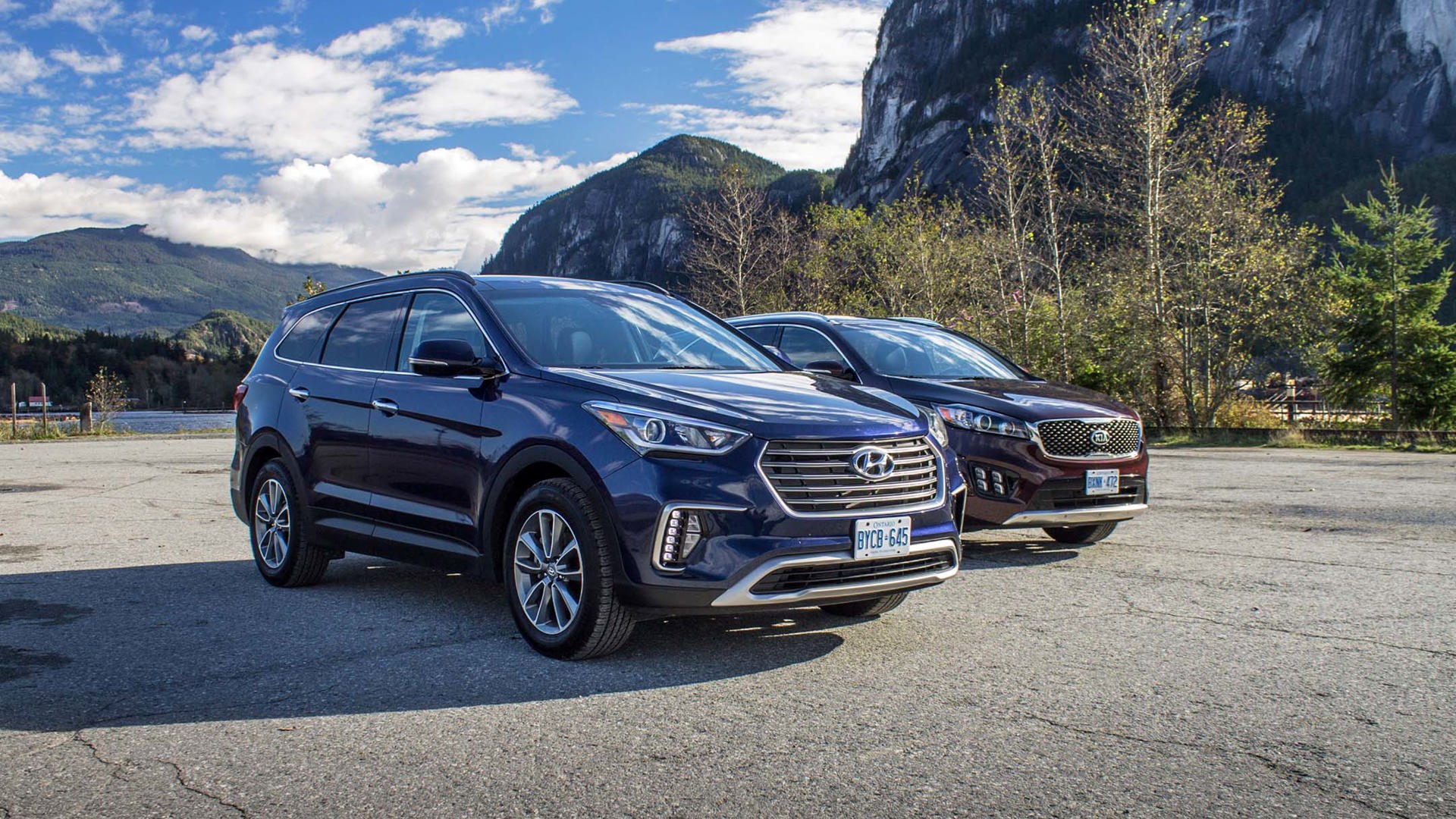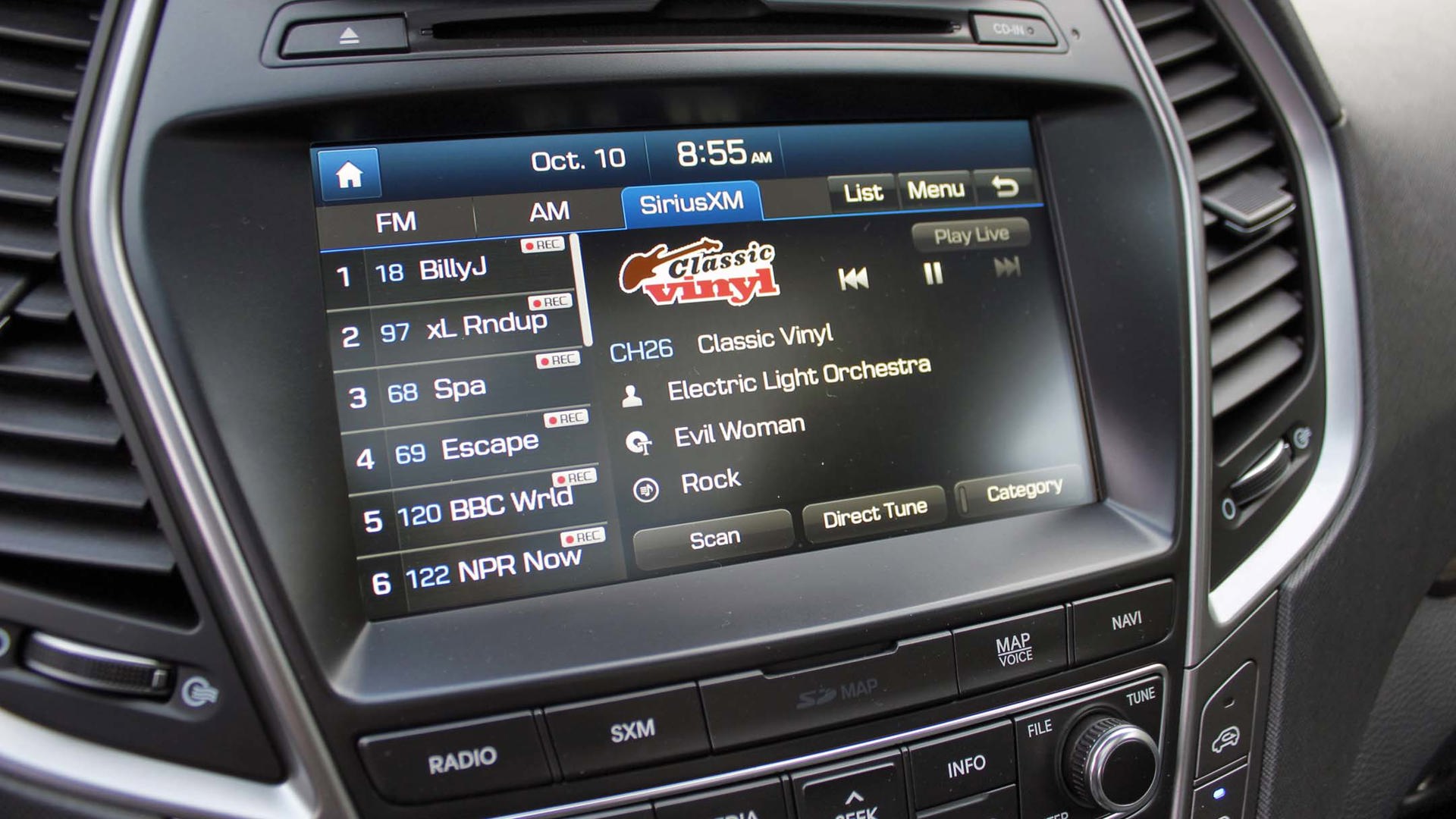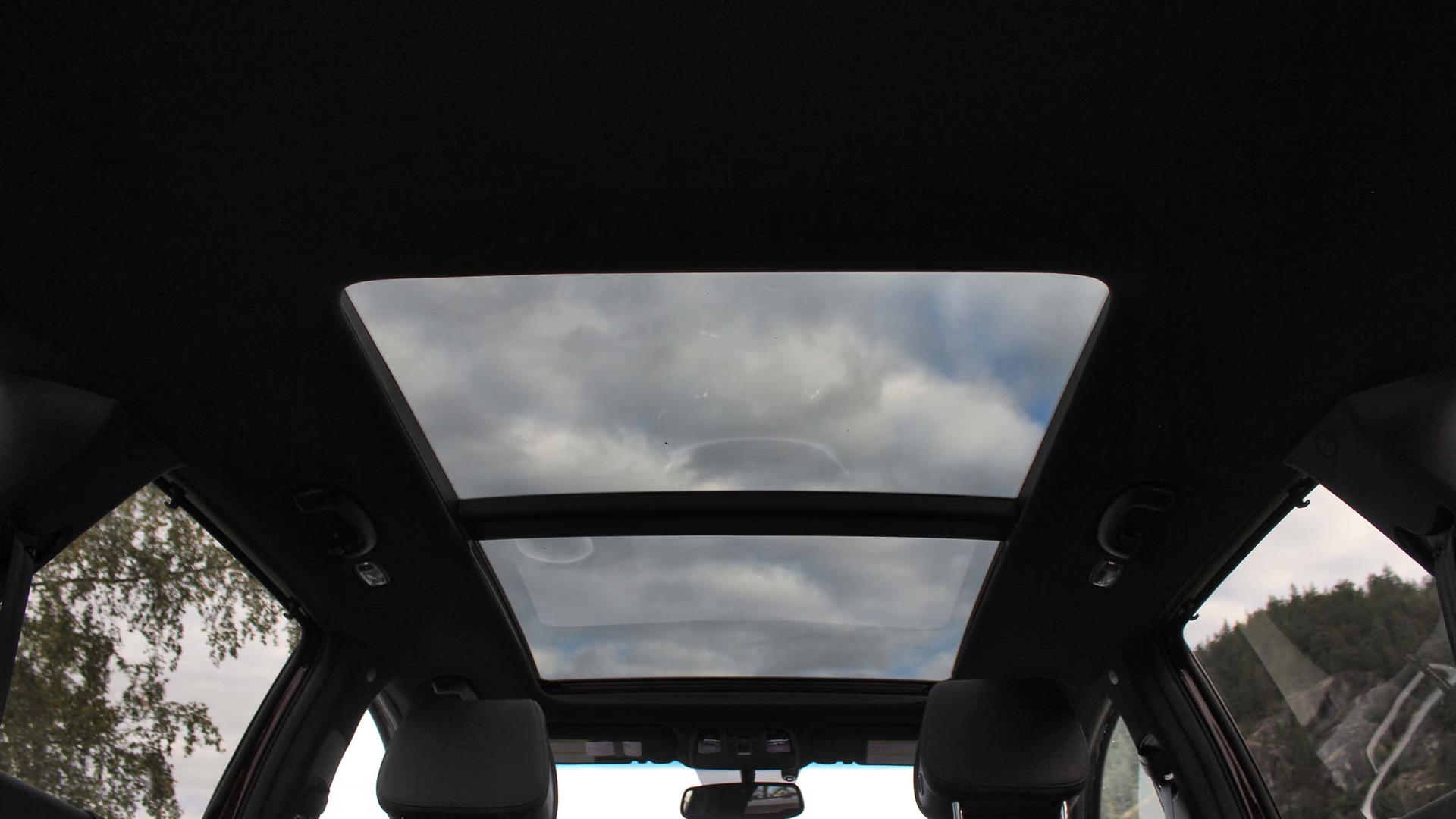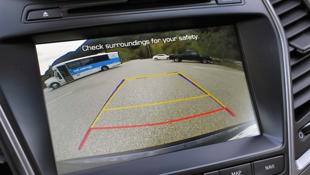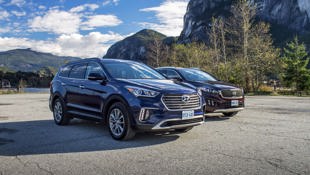Comparison Data
|
2017 Hyundai Santa Fe XL Luxury
|
2017 Kia Sorento SX
|
|---|---|
|
Engine Displacement
3.3L
|
2.0L
|
|
Engine Cylinders
V6
|
I4
|
|
Peak Horsepower
290 hp @ 6,400 rpm
|
240 hp @ 6,000 rpm
|
|
Peak Torque
252 lb-ft @ 5,200 rpm
|
260 lb-ft @ 1,450 rpm
|
|
Fuel Economy
13.0/9.7/10.8
|
12.3/9.4/11.0
|
|
Cargo Space
1,158/2,265 L
|
1,099/2,082 L
|
|
Base Price
$42,599
|
$42,495
|
|
A/C Tax
$100
|
$100
|
|
Destination Fee
$1,895
|
$1,740
|
|
Price as Tested
$44,594
|
$44,335
|
|
Optional Equipment
None
|
None
|
Brendan says:
Thirty years ago, a pair of Korean automakers prepared the groundwork for the two mainline crossovers you see here today. In a time when Bryan Adams was not only tolerated, but actually encouraged to sing, Hyundai arrived in Canada just as Kia was beginning to manufacture passenger cars again. Over a tumultuous three decades, both companies have arrived at a position where they are inextricably entangled: Hyundai owns about a third of Kia, and Kia owns portions of all sorts of Hyundai subsidiaries.
It’s not a tie between equals, one of these Korean-made machines is better.
In that long-ago summer of ’86, the pair of fledglings left the nest with humble passenger cars and designs borrowed from other car-makers. Now, they stand side by side with pretty much anything else on the market. The Sorento, which sells the most strongly of all Kia products, is in the top thirty vehicles purchased by Canadians. The Sport version of the Santa Fe (our tester is the related but slightly longer Santa Fe XL) cracks into the top twenty.
Crossovers are where it’s at these days, and these two represent the vehicles Kia and Hyundai wish to sell to families. Mid-size sedan sales are sliding and minivan sales tanked a long time ago – this is what Kia and Hyundai think the family truckster should look like.
The thing is, with two such similar vehicles, where do you begin to pick them apart? It’s not just country of origin, the Kia/Hyundai overlap means their vehicles often share engines, transmissions, and chassis components. They are the product of similar business plans, similar engineering, and similar marketing. They have nearly identical price tags.
And yet, the Sorento is different from the Santa Fe. They drive differently, have unique packaging layouts and different brand values. It’s not a tie between equals, one of these Korean-made machines is better.
Styling
Dan Says:
Hard to say who wins here, really; hard in that these are mid-size crossovers, and styling is often not priority number one in either the customer’s or manufacturer’s mind, and hard in that they both look pretty good. Nothing special, but completely inoffensive in every possible way. Which, or course, is how each manufacturer would like to have it.
I guess the first thing that jumps out at you when it comes to the 2017 Hyundai Santa Fe XL is the fact that even though this is technically the longer “XL” version, you really have to look very closely in order to figure that out. The width of the D-pillar is the main giveaway, but for those with eagle eyes only.
Otherwise, the Santa Fe XL does a similar job to its Sport sibling: wheels pushed to all four corners for a more athletic-looking profile, and tapered side windows to further drive home the effect. Up front, the signature Hyundai grille dominates the proceedings, but look more closely and pleasing details like the stacked foglights and aluminum lower splitter come into focus. I’ll also take those two-colour 18-inch wheels any day of the week. Same goes for the twin-outlet exhaust, which does a good job of demonstrating that the V6 under-hood is no shrinking violet. But more on that in a minute.
Inside, you can see the trends started by the Elantra and Sonata when Hyundai went through a bit of a rebirth in the early 2010s. Curvy shapes abound in the XL, from the angular vents on either side of the centre stack, to said centre stack itself, which is a nicely tapered affair whose shape both looks good, and allows for more knee space as the corners of the stack aren’t jutting into your knees as much. The shape is reflected in the steering wheel spokes, which house your volume, cruise, phone and trip computer controls.
Being of the “Luxury” trim variety, our tester had a few added niceties, including leather seating and wood inserts. Nice touches all.
As we turn to the Kia, we see why this can be a tough one to judge; it’s very different-looking both inside and out, but has a few nice touches that make it unique in the segment. The grille, for its part, is spectacular in its gorgeous faux-aluminum finish, and it’s nicely framed by the optional ice-cube-like foglights that made their debut on the all-new Sportage. They looked a little strange there, but fit well on the Sorento because they don’t awkwardly take up so much of the front fascia’s real estate. Like the Santa Fe, there’s an underbody skid plate here, too.
While I liked the Santa Fe’s wheels, the Kia’s take them to the cleaners in the styling department. They’re the same size as the Santa Fe’s, but their styling gives them more presence and manages to better draw the eye away from the rubber around them.
Unfortunately, the rear fascia doesn’t have quite the same effect. The taillight lenses are too small, appearing to float awkwardly within the tailgate panel around them. The rear window is also tiny, which makes not only for a strange look, but a worse view out, as well.
Inside, I’d have to say the Sorento displays a more grown-up air. It’s very monochromatic, for one, and comes with a fantastic leather-topped dash that the example in the Santa Fe can’t quite replicate. Our tester was pretty black-on-black-on-black, a theme broken up only by bright silver accents around the infotainment display screen, cup holders and around the vents plus on the pedal surfaces. You won’t find any faux-wood here, that’s for sure. There may be some who’ll take issue with a lack of choice when it comes to interior colours – your only choice is black, unless you upgrade to the top-spec SX+ V6 trim, which opens up a beige colour choice.
Which is the better look? Well, I guess I’m a little biased in that I’m kind of anti-wood-grain, especially the faux variety. Open-pore wood – as we’re seeing in many parts of the car world – is fine. In this case, however, I’ll take the Sorento’s treatment. Even with the lack in colour choice, the materials used, the styling and the general ambiance tick the right boxes.
Brendan says:
I like how Kia apparently designs their grilles to look like a giant bottle-opener. Both crossovers seek to fade into parking lot anonymity, but I prefer the Sorento’s more Germanic appeal, inside and out.
Performance/Handling
Brendan says:
No one who has ever had to clean kid-vomit out of a car seat is going to worry too much about cornering forces and slalom times from these two. The family-hauler segment is an area where the quality of the ride is more important than its quickness. Notable exceptions include the Honda Pilot and the Mazda CX-9, but the bulk of the market is bulky for a reason. Think on the Toyota Highlander, which lacks nimble handling, but may therefore feel more secure to the average driver simply by virtue of a planted feel.
In a straight line, there’s little to pick these two apart. The Sorento’s 2.0L turbocharged four-cylinder is down on power next to the Santa Fe’s 290 hp V6, but by 4,000 rpm, both engines are making approximately the same amount of torque. For brief passing maneuvers, accelerating down on-ramps, and simply getting a laden vehicle off the line, the pair will run neck and neck.
However, our test route took us up the sweeping curves of the Sea-to-Sky highway, and here our two Koreans diverged markedly. While neither one of them will be setting any Nürburgring records any time soon, the Sorento does manage to back up its Q7-ish looks with a modicum of poise.
While the Sorento’s styling hasn’t seemed to change much in the past half-decade, it was comprehensively updated under the skin for the 2016 model year. The Santa Fe, by contrast, rides on an older platform. The Kia is a little lighter than the Hyundai, but it manages to feel more planted through the corners.
What the Santa Fe offers is not just smoothness, but a disconnect from the road. The steering is completely void of feel – why, when Hyundai called Lotus in to tweak the Genesis sedan’s steering, did they not have the company go through the rest of the range? The Hyundai glides just fine, but it’s a bit of a pillow.
The Sorento equals the Santa Fe in comfort, but it feels composed rather than aloof. Here, the drive is about confidence in the platform, and giving the driver some idea of what’s going on beneath them. I’d love to have the XL’s sweet-revving V6 in the Kia (a V6 is an option at the top end), but otherwise it’s advantage: Sorento.
Dan says:
Have Lotus go through a range of SUVs and crossovers? I dunno, Mr. McAleer; that seems a little much, doesn’t it?
Maybe not, though. I’m sure similar things were said when, after decades of building lightweight sports- and racing cars, Lotus got their crack at the massive Carlton all those years ago. So maybe a little tweak of the Santa Fe’s handling at their hands wouldn’t go amiss. The Santa Fe is, after all, a big seller for Hyundai, so why not give it the full beans when it comes to development? Guess they didn’t want to slice those margins too thin.
At any rate, I have to agree with Brendan, but I do have a different take on what the two handling packages actually offer. The Santa Fe really is buttery smooth, gliding over bumps and berms on the highway with relative ease, its longer (by 120 mm) wheelbase making for more comfortable progress over smaller bumps and berms. Brendan calls it “more aloof”, and while that may be true, I think buyers of a V6-powered, three-row crossover will take the comfort it provides.
The Sorento is the handler of the two, though. If your weekend holidays involve a lot of winding b-road work, then the Sorento may be the better choice as it inspires a little more confidence as the going gets twisty. The feeling of good turn-in was amplified in the case of our test thanks to the Sorento having a smaller, lighter engine up front. It’s less powerful, sure, but Kia/Hyundai’s 2.0L turbo GDI motor is a good one that works well with the six-speed transmission to make for sprightly forward progress. Yes, it gets a little wheezy as grades increase, but even on our mountainous test route, passing at highway speeds rarely presented much of a problem.
Those may arise, of course, as the vehicle gets more laden, which is why the Santa Fe XL comes equipped only with the V6, and why if you want seven seats in your Sorento, you’ll have to make the transition, too. Brendan says the Sorento is the winner here, and while I tend to agree with him, the Santa Fe XL remains very good at what it’s meant to do. Which is all many want from their car or SUV, right?
Comfort
Dan says:
While the Santa Fe XL has the benefit of being one of two Santa Fe models available, the Sorento kind of has to walk the line for two models at Kia: a standard two-row mid-size crossover as well as one that is able to haul seven occupants.
It’s strange that the Sorento’s three-row version actually has more room in the third row than the Santa Fe, even though the Hyundai is both longer overall and has a longer wheelbase. The trade-off comes in the second row, where the Santa Fe has both more legroom (1,028 mm) and more headroom (1,002 mm) than the Sorento (1,000 mm and 998 mm, respectively). It also has more cargo capacity than the Kia.
The only place you really feel the difference, though, is in the third row as the first and second rows in both the Kia and Hyundai are so close that a difference is hard to spot.
Where I did notice a marked difference, however, was in the Santa Fe’s front seat, which has you feeling like you’re sitting a lot higher up than you are in the Sorento. If you’re a shorter driver, then I guess this is okay but it was awkward for me and my 6'3" frame. The Sorento, on the other hand, provides a much more “ensconcing” seating position, and some nicely supportive seats to boot. The driver’s seat in the Sorento, however, is adjustable 14 ways while the Santa Fe’s is a 12-way power seat.
Otherwise, you can see why we’ve got another “split the difference” situation between these two. there are plenty of easily accessible cup holders and storage bins in each (though the centre storage bin in the Hyundai doesn’t suffer from the rude intrusion of the USB port housing found in the Sorento), both have reclining second-row seats and wonderfully flat rear cargo floors with the seats folded.
So the real difference makers, then, is the front seat seating position and that third row. The thing about the third row is, I don’t think I’d choose either of these if the third row was a big issue as the 2017 Mazda CX-9 is more comfortable there than either of these two. In that light, I give the comfort laurels to the Sorento, even if it does give a little head- and legroom away to the Santa Fe on paper.
Technology
Brendan says:
This category again shows the similarities between our soft-roaders. However, the Sorento has an advantage in hard tech that’ll be of interest to passengers: there are USB ports all over this thing, and even a 110V socket so that rear-seat riders can plug in a laptop. In terms of infotainment, sometimes keeping the kids fed with screen time is the difference between a happy road trip and checking yourself into the insane parent asylum.
Further, the Kia’s interface is a little better than the Hyundai’s. Both operate with similar speed and functionality, but the Sorento’s looks a little fresher. Kudos to both for having lots of redundant knobs for volume and tuning and so forth.
When it comes to safety, the Santa Fe has more on offer – if you’d like to pay for it. Moving up to the Ultimate grade XL nets you a 360-degree camera (available in the SX+ Kia as well), and an autonomous emergency-braking system (not available from Kia). Add in the Hyundai’s adaptive cruise control, and it’s got more stuff.
However, at the mid-trim model where most intenders will be looking, these two crossovers are essentially tied. I’d again give the nod to the Sorento for the day-to-day practicality of having more plug-in points.
Value
Dan says:
If tech is the top priority for you, then between these two I have to hand it to Kia. Front and rear USB ports (the Santa Fe has one up front), four 12V outlets (the Santa Fe has two), an actual 110V socket accessible from the second row, heated and cooled front seats and a better-looking infotainment interface are big value added points for the Kia.
Not to mention that if you want three-row seating in your Sorento, you can get it at the EX+ trim level, which actually saves you about $4,000 over the similarly equipped Santa Fe XL Luxury trim package.
Having said that, if V6 power is what you’re after, then the fact that you can get it all the way down at base trim in the Santa Fe is mighty attractive. Actually, with the Santa Fe you get more flexibility in general as every trim comes standard with the V6. Of course, you can go the other way with the Sorento, too, and spec the base 2.4L non-turbo four, if you’re willing to forego AWD. A rare choice among Canadian buyers, I’m sure.
Brendan says:
I can’t imagine how miserable a four-cylinder Sorento would be, with all that weight to move around. It’s not like the fuel economy’s much different on the highway: 9.3 L/100 km for the 2.4L and 9.4 L/100 km for the 2.0L turbo.
Conclusion
Dan says:
I guess I love that you can get a V6 no matter the trim in the Santa Fe and it’s also just barely pips the Sorento in the exterior looks department. Thing is, there’s just so much to like about the Kia. The interior is a high-class and well-equipped affair, the seating position is just right, it’s got a more usable third row and while the V6 in the Santa Fe is nice, the Sorento is the better-handling car of the two. Plus, when you compare apples to apples in the trim sense, it’s a better deal. It’s the one I’d have, when push comes to shove.
Brendan says:
There’s a reason the Sorento is the best-selling Kia product. It’s well-packaged, right-sized for Canadian families, and it looks higher-grade inside and out than you’d expect from a mainstream brand. The Santa Fe’s a good machine too, but is due for a full refresh – and the driving dynamics have a whiff of minivan about them. I’m sure Santa Fe is a lovely place to visit, but if I were you, I’d plan your next vacation in Sorento.

